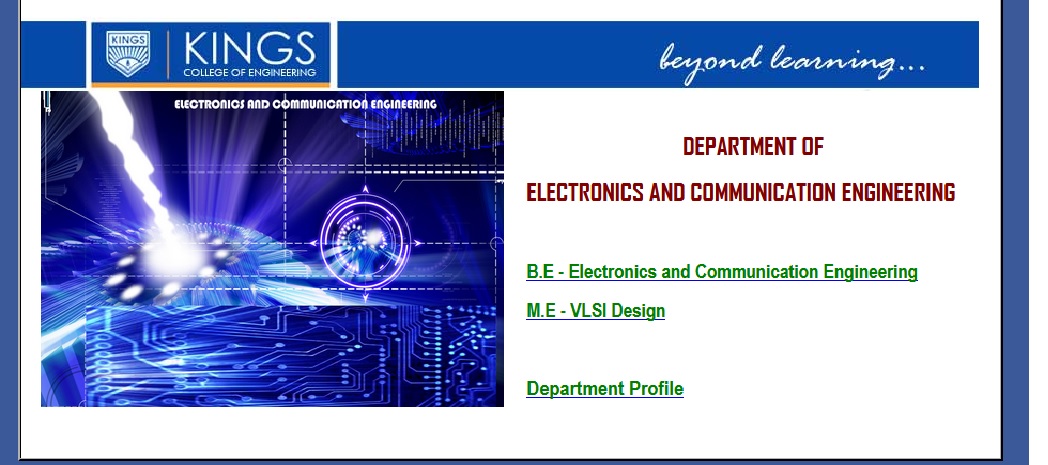EE1353 Power Electronics Question Bank : kings.ac.in
Name of the College : Kings College Of Engineering
Department : Electrical & Electronics Engineering
Subject : Power Electronics
Website : kings.ac.in
Document Type : Question Bank
Download Model/Sample Question Paper : https://www.pdfquestion.in/uploads/ki…LECTRONICS.pdf
Kings Power Electronics Question Bank
Unit-I
Power Semiconductor Devices :
Part-A :
1. What are the different methods to turn on the thyristor?
2. Define latching current.
Related : Kings College of Engineering CS1029 Network Security Question Bank : www.pdfquestion.in/1318.html
3. Define holding current.
4. What is a snubber circuit?
5. Why IGBT is very popular nowadays?
6. What is the difference between power diode and signal diode?
7. What are the advantages of GTO over SCR?
8. What losses occur in a thyristor during working conditions?
Part-B :
1. Draw the two transistor model of SCR and derive an expression for anode current. (8)
2. Explain the characteristics of SCR (8)
3. Describe the various methods of thyristor turn on. (16)
4. Explain the operation of MOSFET and IGBT (16)

Unit-II
Phase-Controlled Converters :
Part-A :
1. What is the function of freewheeling diodes in controlled rectifier?
2. What is commutation angle or overlap angle?
3. What are the advantages of six pulse converter?
4. What is meant by commutation?
5. What are the types of commutation?
6. Mention some of the applications of controlled rectifier.
7. What are the different methods of firing circuits for line commutated converter?
8. What is meant by natural commutation?
9. What is meant by forced commutation? In this commutation, the current flowing through
Part-B :
1. Describe the working of 1 _ fully controlled bridge converter in the Rectifying mode and inversion mode. And derive the expressions for average output voltage and rms output voltage. (16)
2. Describe the working of 3 _ fully controlled bridge converter in the Rectifying mode and inversion mode. And derive the expressions for average output voltage and rms output voltage. (16)
3. Describe the working of Dual converter. (16)
4. Derive the expressions for average output voltage and rms output voltage of 1 _ semiconverter. (16)
Unit-III
DC To DC Converters :
Part-A :
1. What is meant by dc chopper?
2. What are the applications of dc chopper?
3. What are the advantages of dc chopper?
4. What is meant by step-up and step-down chopper?
5. What is meant by duty-cycle?
6. What are the two types of control strategies?
7. What is meant by TRC?
8. What are the two types of TRC?
9. What is meant by PWM control in dc chopper?
Part-B :
1. Describe the principle of step-up chopper. Derive an expression for the average output ] voltage in terms of input dc voltage & duty cycle. (16)
2. Describe the working of four quadrant chopper. (16)
3. Explain the working of current commutated chopper with aid of circuit diagram and necessary waveforms. Derive an expression for its output voltage. (16)
4. Explain the working of voltage commutated chopper with aid of circuit diagram and necessary waveforms. Derive an expression for its output voltage. (16)
Unit-IV
Inverters
Part-A
1. What is meant by inverter?
2. What are the applications of an inverter?
3. What are the main classification of inverter?
4. Why thyristors are not preferred for inverters?
5. Give two advantages of CSI.
6. What is meant a series inverter?
7. What is meant a parallel inverter?
8. What are the applications of a series inverter?
9. What is meant by McMurray inverter?
10. What are the applications of a CSI?
11. What is meant by PWM control?
12. What are the advantages of PWM control?
PART-B :
1. Describe the operation of series inverter with aid of diagrams. Describe an expression for output frequency, current and voltages. What are the disadvantages of basic series inverter? (16)
2. State different methods of voltage control inverters. Describe about PWM control in inverter. (16)
3. Explain the operation of 3 _ bridge inverter for 180 degree mode of operation with aid of relevant phase and line voltage waveforms. (16)
Unit-V
Ac Voltage Controller
PART-A :
1. What does ac voltage controller mean?
2. What are the applications of ac voltage controllers?
3. What are the advantages of ac voltage controllers?
4. What are the disadvantages of ac voltage controllers?
5. What are the two methods of control in ac voltage controllers?
6. What is the difference between ON-OFF control and phase control?
7. What is meant by cyclo-converter?
8. What are the two types of cyclo-converters?
9. What is meant by step-up cyclo-converters?
10. What is meant by step-down cyclo-converters?
11. What are the applications of cyclo-converter?
PART-B :
1. Explain the operation of multistage control of AC voltage controllers with neat diagram. (16)
2. Explain the operation of 1_ AC voltage controller with RL load. (16)
3. Explain the operation of 1_ sinusoidal AC voltage controller. (16)
4. For a 1 _ voltage controller, feeding a resistive load, draw the waveforms of source voltage, gating signals, output voltage and voltage across the SCR. Describe the working with reference to waveforms drawn. (16)